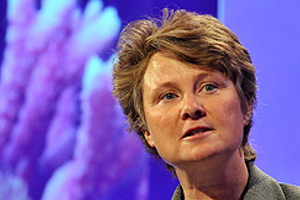I watched a total of three videos, each approximately twenty minutes long where Janine Benyus talked about biomimicry. She believes that we can mimic structures we see in nature to create useful products that work closely with our natural world. One topic that stood out to me is the use of 3D printers. Generally in our manufacturing systems people take materials and cut away from them to make the products we need. This creates waste and ends up depleting natural resources in the process. Instead Janine is pioneering for the use of additive manufacturing. This is where we figure out what product we need and layer by layer build it. In this way, we have theoretically no waste. She also spoke about using common polymers that exist in any ecosystem and layering this same material in different ways. This will allow us to create structures from one material and give them color, structure, breath-ability, and be abrasion resistant just by the way we layer them. She later spoke about using the “recipe” or “blueprints” from nature to create products that we will use every day. The example she used for this idea are the wings of a dragonfly mimicked to create durable types of plastic. This type of plastic made from polymers is biodegradable so it can return to nature after its life. I really enjoyed the thoughts and ideas that she expressed in these videos. I feel that it would be beneficial for people to continue research on these topics and start utilizing these ideas in the real world. The overall theme that Janine was trying to display is how human beings can live gracefully on this planet for the long haul. It is no secret that we are destroying our natural world, if we adopt these new thoughts and practices of manufacturing we may be able to reverse some of the effects of what we have done.
Damn, Another Ecologist
I also read the first two chapters of the book The Nature of Economies. Many of the ideas that I grasped from this reading are along the same lines of what Janine Benyus was saying about biomimicry. The book begins with mentioning four characters that have differing opinions on nature and the way in which we currently interact with it and possibly the way we should. The character Hiram speaks about the possibility of manufacturing products with life-friendly materials, without toxic chemicals. He went on to say that by imitating nature and its chemistry we can create products that are benign; therefore at the end of their useful life they can be returned to the land and sea. From here was a discussion primarily between Armbruster and Hiram about how economics can be learned from nature. This statement was made by Hiram who stated that development is what brought him to this conclusion. Later in the book Hiram goes on to explain how development can be defined as, “significant qualitative change, usually building up incrementally.” There are three fundamental principles to development, according to Hiram. The first, “development is differentiation emerging from generality.” He chose the example of the solar system. There are astronomers and physicists that believe the solar system is a vast cloud of matter, which is a generality. Then differentiations occurred: the sun, planets and their moons, and various other debris. Then once the Earth emerged as a differentiation, it became a new generality from which further differentiations could emerge. The second principle of development is that differentiations become generalities from which further differentiations emerge. These occur simultaneously in parallel and others in successions. The last principle is that development depends on co-development. Meaning, that development can’t usefully be thought of as a ‘line,’ or even as a collection of opened ended ‘lines.’ Overall, what I was able to grasp from this reading is that there are ways in which we can interact with nature and learn from it. That continuous development is necessary and it happens without our notice or concern. We need to understand development as a means to interact with our natural world. Specifically, “development isn’t a collection of things but rather a process that yields things.” I look forward to reading more about how and for what reason we have so many developments. Also, how we may change some of these new developments to work better in our world as opposed to stripping it of something.


